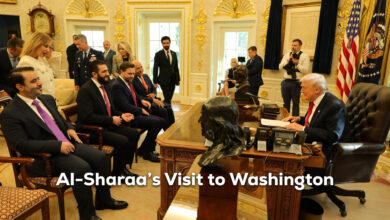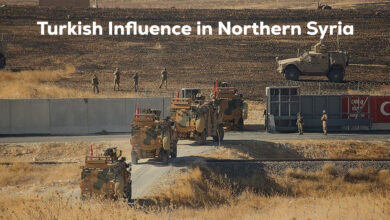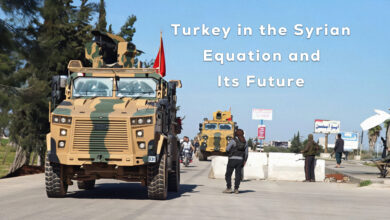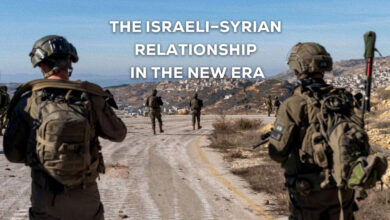From the Suwayda Protests to Deir Al-Zor Strife Backgrounds and Results
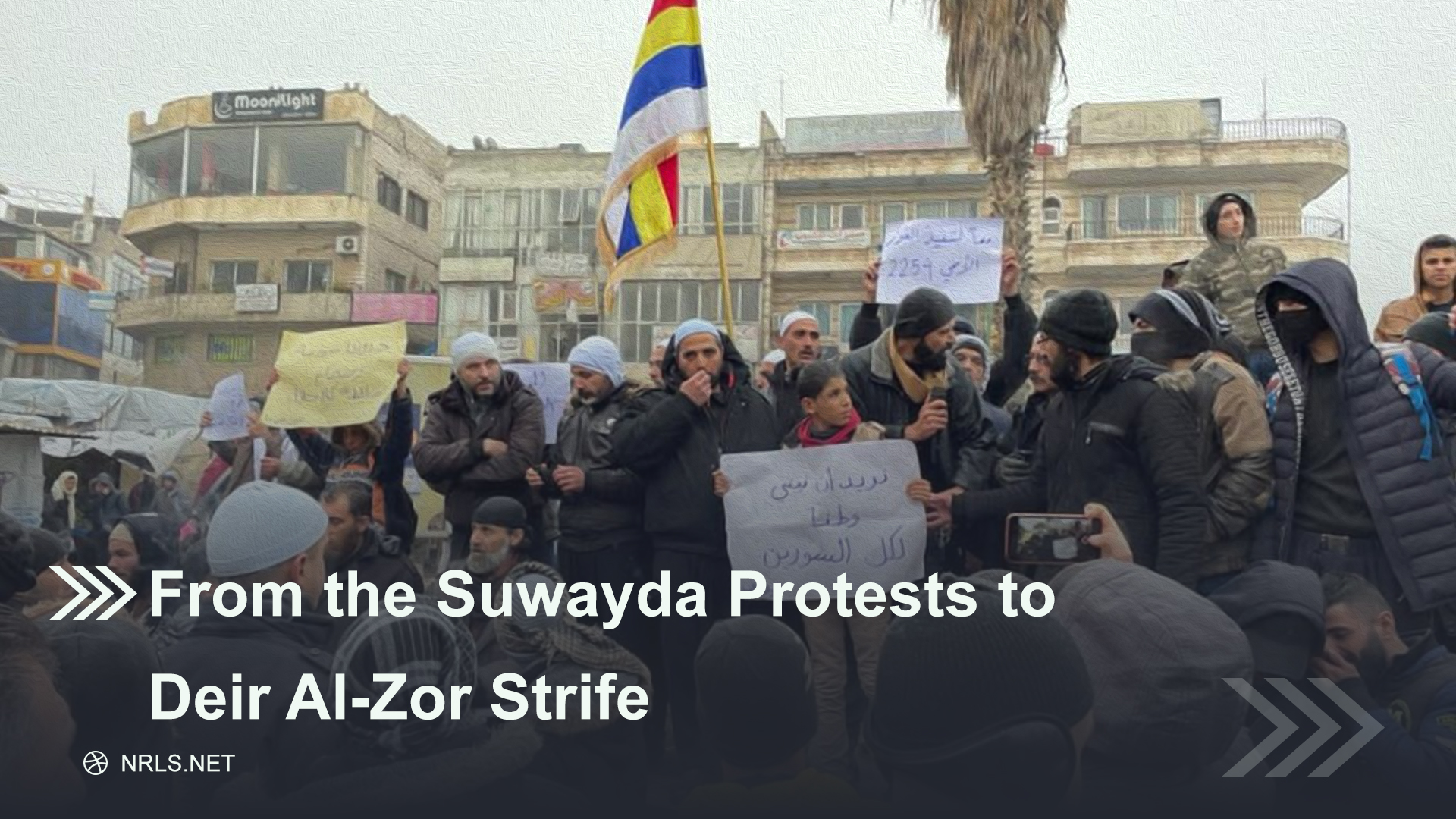
Introduction:
The Syrian crisis is witnessing international, regional and internal movements represented by factions and agents fighting on behalf of their supporters, on Syrian soil, from the United States of America, Russia, Turkey, Iran and Arab countries such as Jordan, Iraq and Saudi Arabia, who proposed the Arab Initiative and returned Syria to the Arab League, and attempted to implement UN Resolution 2254. / And achieving “step by step”, which demonstrated the failure of the Syrian regime and its inability to achieve any required step, at a time when Turkey is trying to normalize relations with the Syrian regime, which stipulated the Turkish withdrawal from northern Syria, and which Erdogan declared the impossibility of withdrawal unless terrorism is eliminated, this means eliminating the Autonomous Administration and the Syrian Democratic Forces.
The Syrian regime is suffering from a stifling economic crisis after the deterioration of the Syrian pound against the US Dollar, which had its effects on the living situation, especially after the lifting of fuel subsidies, especially in the west of the Euphrates, areas of influence of the Regime, Iran, and Russia, which pushed the matter towards protests and demonstrations in Suwayda, then to divert attention from it. The regime and Iran have sparked strife in Deir Al-Zor, the relationship between the two events and the two governorates is close.
Suwayda Protests:
Al-Suwayda is located in southern Syria, next to the city of Daraa, and it is extremely important from a strategic and geopolitical standpoint. It is close to Beirut / Lebanon, Amman the capital of Jordan, and it is close to Israel, as it is close to the Syrian capital, Damascus. It is unique in its religious specificity, as its residents are from the Druze monotheist sect, and they have an extension within Israel, Jordan, and Lebanon, and they have a historical background from the formation of mini-states in the Levant in the Ottoman period, so they are Maanis. The descendants of Fakhr al-Din al-Maani and the Grandsons of the Shihabis and their leader, Bashir al-Shihabi. They are peaceful in the countries in which they live, and are distinguished by courage, dignity, pride and chivalry. Among their men in Syria is Sultan Pasha al-Atrash, the leader of the Syrian revolution of 1925 against the French occupation, who fought the French and fled their persecution to Jordan. The Suwayda protests have been continuing since the first week of September 2023 until today, which is still a source of concern for the regime and its Iranian and Russian allies, who are striving to prevent the protests from spreading to other Syrian governorates.
Although it extended to the city of Daraa and to the Damascus countryside in the city of Jaramana, against the backdrop of deteriorating living conditions and the removal of fuel subsidies that were mentioned previously, the demonstrators reached the point of raising the slogan “Bring down the regime,” removing pictures of Bashar al-Assad from institutions and municipalities, and uprooting the statue of former president Hafez al-Assad. The residents of the city of Suwayda are demanding their own self-administration, and they have local forces to protect the city and institutions from within it, and despite the attempts of the regime and Iran to send infiltrators from their followers from ISIS and the surrounding Bedouin tribes, these demonstrations have resonated inside Syria and in most Syrian cities despite the distortion practiced by the regime. The Syrian media supported the media hostile to them and to any Syrian national movement, such as the media of Hezbollah, the Iranian Revolutionary Guard, and others, in order to show this movement and isolate it as if it were only in the city of Suwayda. However, the facts indicate that demonstrations in support of their protests took place in some European countries, and even more than 20 European parliamentarians have supported the Suwayda protests, in order to hide and cover up these demonstrations and protests, the regime diverted attention from them by causing strife in the city of Deir al-Zor.
Deir al-Zor city:
The city of Deir al-Zor entered the Syrian map in 1946. That is, after Syria gained independence from the French colonialists, it has an important location on the Euphrates River and on land trade routes leading to Iraq, the Gulf and India. Deir al-Zor is located in eastern Syria and forms a strategic border with the Iraqi Republic. It is also rich in water and diverse agricultural production such as grains and vegetables. In addition to its richness in petroleum materials; It contains the “Al-Omar” oil field and the so-called “Conoco gas plant”, which is characterized by gas production, and the Euphrates River passes through the center of the city. The lands located east of the Euphrates belong to the Autonomous Administration in northeastern Syria, and therefore to the United States of America and the international coalition, and the lands west of the Euphrates belong to the Syrian regime and Iran, and their factions and aides.
US-led coalition:
In the light of the upcoming changes in Syria and the region, the United States brought in military reinforcements last month, including vehicles, soldiers, heavy weapons, and F-16 and F-35 aircraft on two aircraft carriers. It also sent / 3,000 / thousand American soldiers to the Red Sea against the backdrop of Iranian provocations in the Gulf and the Strait of Hormuz and Iran’s threat to the oil artery and global energy production in the Gulf and neighboring seas.
These American military reinforcements raised doubts and speculation about a possible battle in the region to prune Iran’s role in Syria and Iraq, limit the spread of its influence in Syria and Lebanon, and cut off the land route for Iranian supply through the Syrian-Iraqi border via Al-Bukamal, Al-Mayadeen, and Deir al-Zor to Damascus and then to Lebanon and Hezbollah. America seeks, at least, to weaken this supply if it is not able to completely block it, to leave a thin line between it and Iran to complete its role in the Gulf from a strategic standpoint, and to try to weaken its role in Yemen, Lebanon, and Syria, especially after Iran’s agreement with Saudi Arabia, which did not bear fruit; especially after the Syrian regime’s faltering in implementing UN Resolution 2254 and the continued flow of smuggling and “Captagon” pills across the Jordanian border. The United States is seeking to strengthen its presence on the Iraqi side of the Syrian border at the “Ain al-Assad” base, and parts of its fleet are present in the Mediterranean Sea, the Gulf and the Red Sea. It also has military bases in Bahrain, Qatar, the Emirates, and other Gulf countries. It also often coordinates with Israel to strike Iranian military bases and its stores of missiles and drones in Syrian territory, and these attacks are almost daily.
The Deir al-Zor Strife and the role of the Regime and Iran in it:
What concerns us is to clarify the hidden hands that are playing behind the scenes, such as Russia, Turkey, and Iran, in cooperation with the Syrian regime, and which are tampering with civil peace in an attempt to mix the cards and incite feelings of hatred for the local population, drag the tribes into Arab-Kurdish strife, and attempt to strike the project of democratic self-administration, the majority of whose forces are made up of Arab tribes in the city of Raqqa, Deir al-Zor, and Al-Hasakah. Russia is striving with all its might to reduce American influence in Syria, Iraq, and the Gulf. Therefore, it is one of the major countries that stands with Iran and the Syrian regime to expel the United States from northeastern Syria, and it meets with Turkey on some issues related to the Kurdish presence in Syria and Iraq.
Turkey is a pragmatic state that adopts a policy of blackmail to achieve its project in the “Milli Pact” of controlling Aleppo, Mosul, and Kirkuk. It continues its aggression with artillery and drones, targeting the civilian population in Syria and Iraq in an attempt to create chaos and create conditions to help the regime and Iran. Its role has also emerged by mobilizing its factions from the National Army and Al-Nusra Front in Manbij, in undeclared cooperation with Russia, the Syrian regime, and Iran in the events and strife of Deir al-Zor, and recently Erdogan’s meeting with the Russian president and Iranian officials took place. As for the Syrian regime, it seeks to restore its influence in Deir al-Zor and the entire Syrian territory, and also aims to restore the oil and gas in “Conoco and Al-Omar field”, agricultural production and others to overcome its economic and living crises. Therefore, its infiltrated Deir al-Zor and ignited strife among its clans through the so-called Abu Khawla (Ahmed Al-Khubail) with his brother and his aides, who headed the Deir al-Zor Military Council, and was in contact with Iranian foreign parties and the Syrian regime, and in relationship with Turkey and ISIS. This is to tamper with the security of the region.
With overwhelming evidence, Syrian forces found weapons stores and drones in his palace in Deir al-Zor, indicating a plan that was hatched by the Syrian, Iranian, and Turkish regime.
Perhaps the events in the city of Al-Hasakah and the attack by the so-called “Abdulqader Hamo,” commander of the National Defense, on one of the sheikhs of the Jabour tribe fall within the context of creating chaos, and perhaps in the same context falls the “Deir al-Zor panic” campaign to supply the city of Al-Hasakah with water tanks. In every movement and attempt by the regime and its agents to stir up strife, the Democratic Self-Administration deals with patience and deliberation, and eliminates all attempts that harm stability and civil peace. The Syrian Democratic Forces confront the strife, combing the area till the last villages in the city, and with the United States meet civilians and tribal sheikhs to achieve justice and stability. And appoint a civil administration from the people of the region, provided that they are among those who are keen to achieve civil peace, and tendentious media channels promote distorting the facts, such as Orient Channel, the channels of the Syrian regime, and channels affiliated with the Turkish media, in addition to social media sites, and the Syrian Democratic Forces confront all of this with patience; In order to preserve the lives of civilians and resolve any local injustice suffered by the population, The Syrian Democratic Forces could had able to resolve matters within a few hours, and the Syrian Democratic Forces will hold a conference for the Arab clans in the city of Deir al-Zor to identify and resolve all issues, and eliminate the root of strife in the city and the entire region.
A final word and possible expectations:
The protests will continue in Suwayda Governorate as long as the economic and living situation is deteriorates. The Syrian regime will continue its policies unless it leaves in accordance with International Resolution 2254 because it is unable to overcome its chronic crises, and this has been proven over decades. Since it was unable to change its structure, central authority, and corruption.
As for the city of Deir al-Zor, its situation will improve economically and in terms of living as long as it remains under the umbrella of the Democratic Autonomous Administration and the Syrian Democratic Forces. There is a possibility of establishing a region managed by the people of Deir al-Zor, which will be allied with the United States and coordinate and cooperate with the Autonomous Administration. As for the Deir al-Zor Military Council It will be renewed through democratic mechanisms that are consistent with the desires of the people.
As for Abu Khawla, his brother, and his aides, they will be brought to fair trials for crimes and security violations they committed, such as cooperation with the regime and foreign parties. The future in Syria is for decentralized governance and democracy, and therefore all regions in Syria will gain self-administrations sooner or later, and we also expect a decline in Iranian influence in Syria and Deir al-Zor regions, Due to the presence of the United States of America and its large concentrations and fleets in the region, Russian influence is in continuous decline due to its crises in the Russian-Ukrainian war and its competition for Iran and its presence in Syria. As for the Syrian regime, it is on leaving. Every crisis he creates reveals more of his weakness and shameless in front the world, and all his Arab, international and regional crises and agreements lead to a dead end and are incapable of achieving security and stability.
As for the Turkish occupation state, it is a state governed by its Ottoman and Ataturk agendas, and it will continue to ravage the lands of neighboring countries such as Iraq and Syria, and will continue to fight the Kurdistan liberation movement, and fight the Autonomous Administration in northeastern Syria, to expand the implementation of the Milli Pact and implement demographic change in Afrin, Ras al-Ain, and Tal Abyad. It threatens Manbij, Ain Issa, and the regions of Aleppo, Tal Tamer, and Abu Rasein with artillery and drones, and targets civilians. It is also working now to achieve cultural change in northern Syria by imposing the Turkish language and teaching 300,000 new children the Turkish language. The Turks have a long history in this field since the days of the Ottoman sultans.
As for the Autonomous Administration in northeastern Syria, it is expected to achieve the necessary necessities for life, such as bread, water, diesel, and electricity, and to improve its administrative performance economically, politically and in livelihood, and to achieve stability, development and coexistence.

